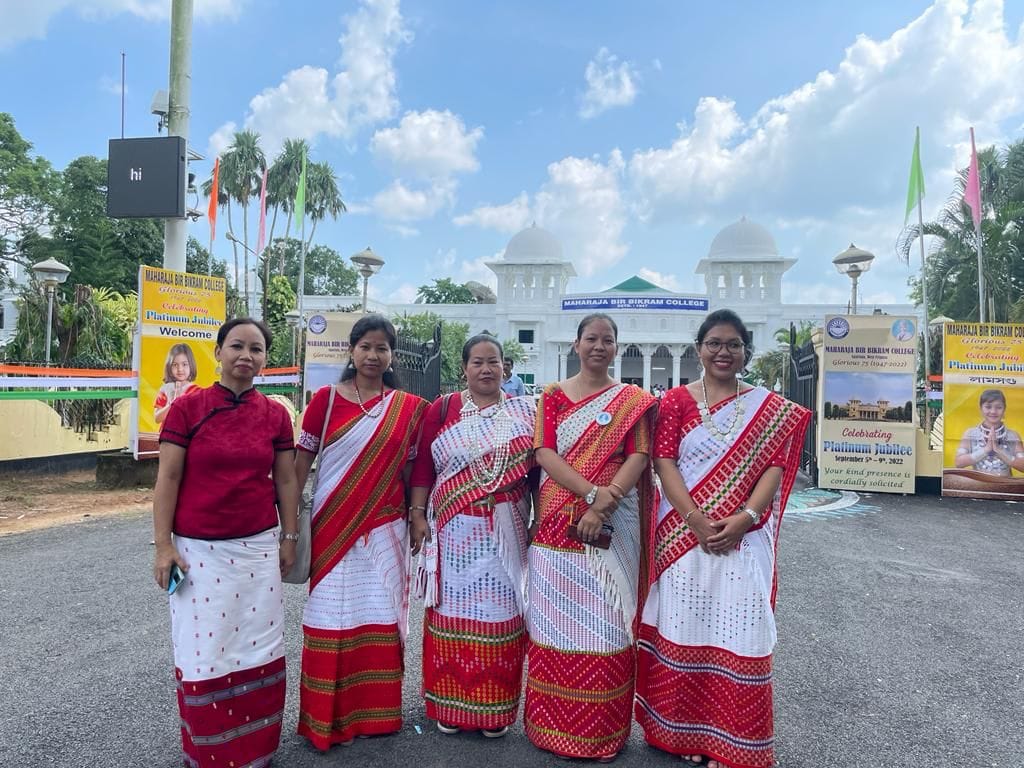By Maria Debbarma

One’s attire is a symbol of one’s cultural identity – serves as a powerful mark that reflects the personnel’s cultural heritage, customs, and sense of belonging holding immense significance in shaping and expressing one’s identity thereby evoking a sense of pride, history within the community, tribe or nation. Traditional attires are the uniqueness of one’s cultural identity, connecting to the roots and embodying the rich cultural heritage of the past (forgotten in many circumstances) down through generations. Wearing traditional attires, is one act among the many rated to be the closest in experiencing what it, could be like to be dressed in a poem while wearing traditional garments but represents personal identity while contributing to the preservation and celebration of community’s traditions. On the other hand, attires, too, signifies correlation of one particular tribe to a particular culture, region or ethnic group that serves as a visual reminder of the values, beliefs, and customs associated with the particular community, tribe or nation based on a person’s conduct, belief and behaviour. It, therefore, holds the power to foster a sense of unity, to appreciate the beauty and significance of one’s traditional (inclusive of garments, practices, rites and rituals that collectively attributes to the formulation or traditional attires).
The Tripura tribes are an indigenous community inhabiting the state of Tripura in North-eastern India. With its rich cultural heritage, the community has distinctive traditional attires that reflect the identity and customs’ uniqueness. To exemplify, mention may be made of ‘ignai’, ‘Risa’ and ‘Rikutu’ wherein the patterns and colours are differentiated in terms of waves (lining of thread), motifs and shades, depending on the clan or the tribe wearing. All the three (mentioned above) are unstitched lengths of cloth that are shaped by their drape. Festivals, weddings, religious ceremonies, and other significant events often see Tripuri women adorned in their traditional garments, showcasing the diversity and richness of cultural heritage. The Tripuri attires originated prior to the ascension of the Manikya dynasty who ruled the region from the early fifteenth century until 1949. The colours, patterns, fabrics, and styles incorporated into the traditional attire of Tripuri community often embedded with symbolism of events or historical past. They may represent historical events, spiritual beliefs, or the natural surroundings and other objects while the skill of weaving is passed on from mother to a daughter. There exist not less than 250 motifs, patterns and combinations of the design of Rignai, Risa and Rikutu.
Rignai- One of the traditional attires worn by women in Tripura is vernacularly addressed as “rignai”. Rignai have always been an intrinsic part of the Tripuri wardrobe, worn as wrapped-around the waist, with a risa or a blouse on top. The most well-known and intricate essence of the rignai is the “Rignai-Chamathwi” – adorned in extravaganza occasions such as marriages, festival, festive dances and the likes. Hand woven rignai-chamathwi or takborokrignai-chamathwi is the most prized possession of Tripuri women. Hence, a woman is never said to be married without a rignai-chamathwi in possession. Traditionally, the colour combination of rignai-chamathwi is red and white whilst the motifs or bwthai are woven using natural colours such as green, yellow, and black. Today, in the midst of all technological advancement, rignai prevails in all its varieties with each individual tribe having its own version, differentiated by motifs and stripes to mark their cultural significances and individuality. Motifs or Bwthais like anji, khamjang, khumbar, takhumtwi, thaiphlokbar etc. and more, inspired from nature and everyday surroundings, may be cited as worthy example of such cultural individuality.
Risa- Risa is hand woven traditional attire worn by Tripuri women as an upper garment. Etymologically, the word Risa is a combination of two Tripuri word ‘Ri’ meaning “Cloth” and ‘bwsa’ meaning “small or short”. In a nutshell, risa is a short, rectangular piece of cloth about 1.5 metres in length and 0.3 to 0.5 metres in width having multi-purpose usages: as wrapper-round, used as shawl by both men and women, used as headgear by men during weddings and festivals and even used to cradle babies. Young girls are given their first risa at the age of their first puberty. This event, in vernacular term, is known as Risa Sormani.
Rikutu- Besides rignai and risa, the Tripuri attires consisted of another important garment the popularly knonw as rikutu – a wrap or drape to cover whole of upper half of the body. Rikutu is a long rectangular piece of cloth about 2.5 metres in length and 0.7 to 0.8 metres in width. At present, rignai and rikutu are draped together with a blouse on top. Tripuri traditional attires not only reflect the cultural heritage of the community but also represent their sense of identifying oneself with sense of pride and belonging. The intricate designs, vibrant colours, and handwoven fabrics used in these clothing showcase the artistic skills and craftsmanship of the come men and women. In the 21st century, Tripuris – the people while embracing modern fashions and styles, traditional attire continued to an important part of their cultural celebrations, festivals, rites and rituals as a means of paying honour and homage to the ancestors, who have safeguarded and preserved the legacy of the community. It also serves as a bridge connecting the past, present and the future thereby ensuring their very point of existence as an individual tribe.
Maria Debbarma is Assistant Professor, Department of Environmental Science, MBB College.
